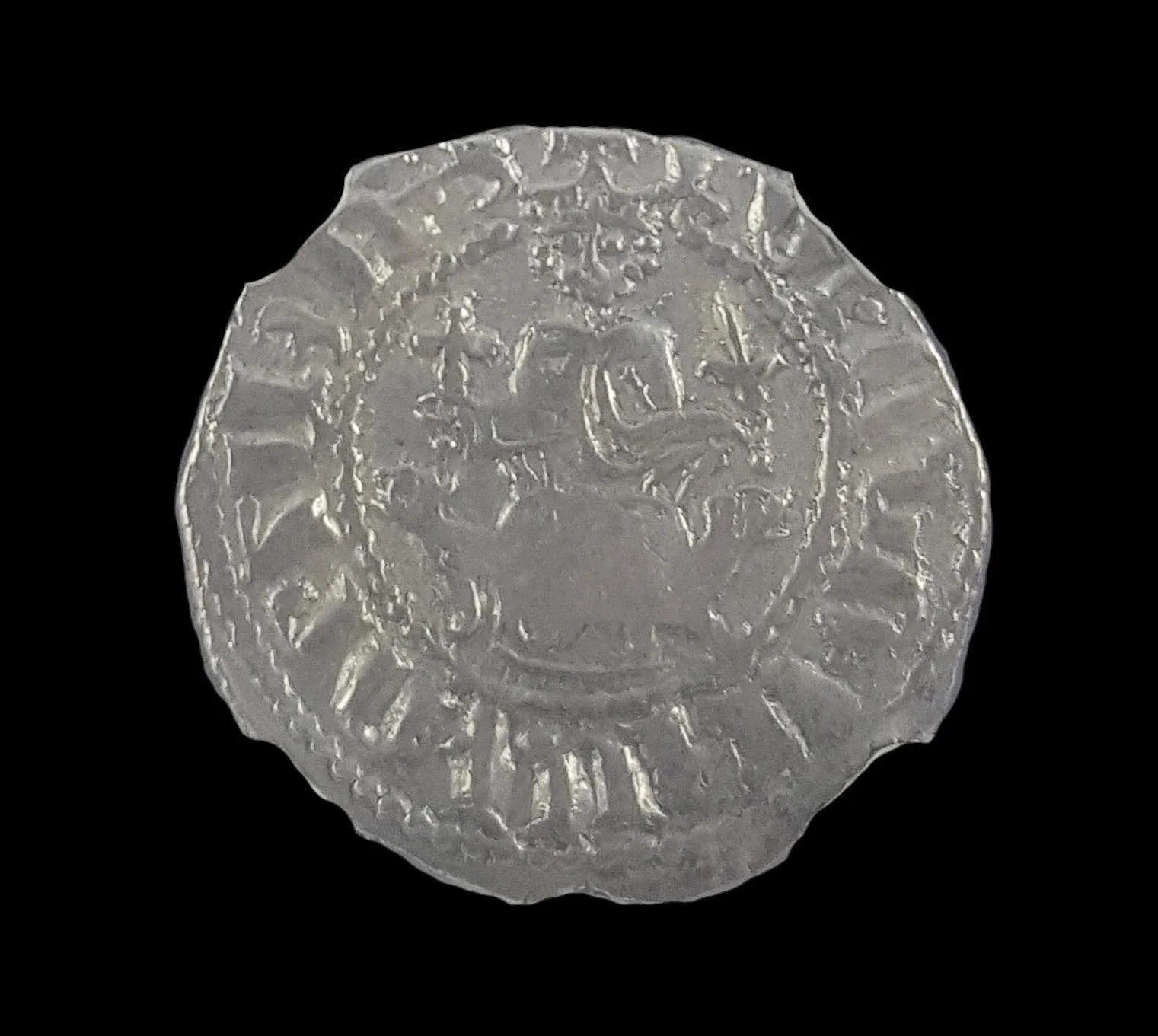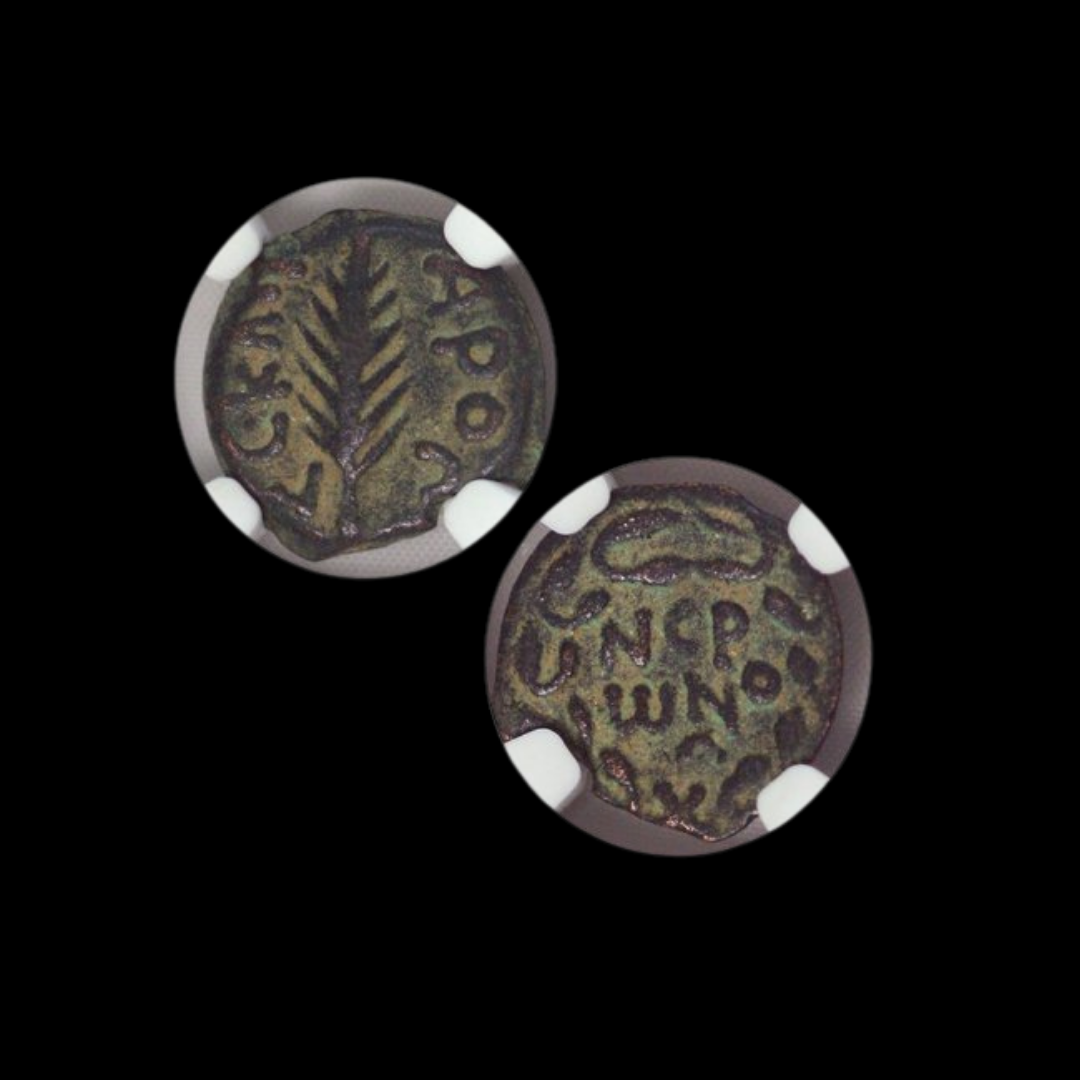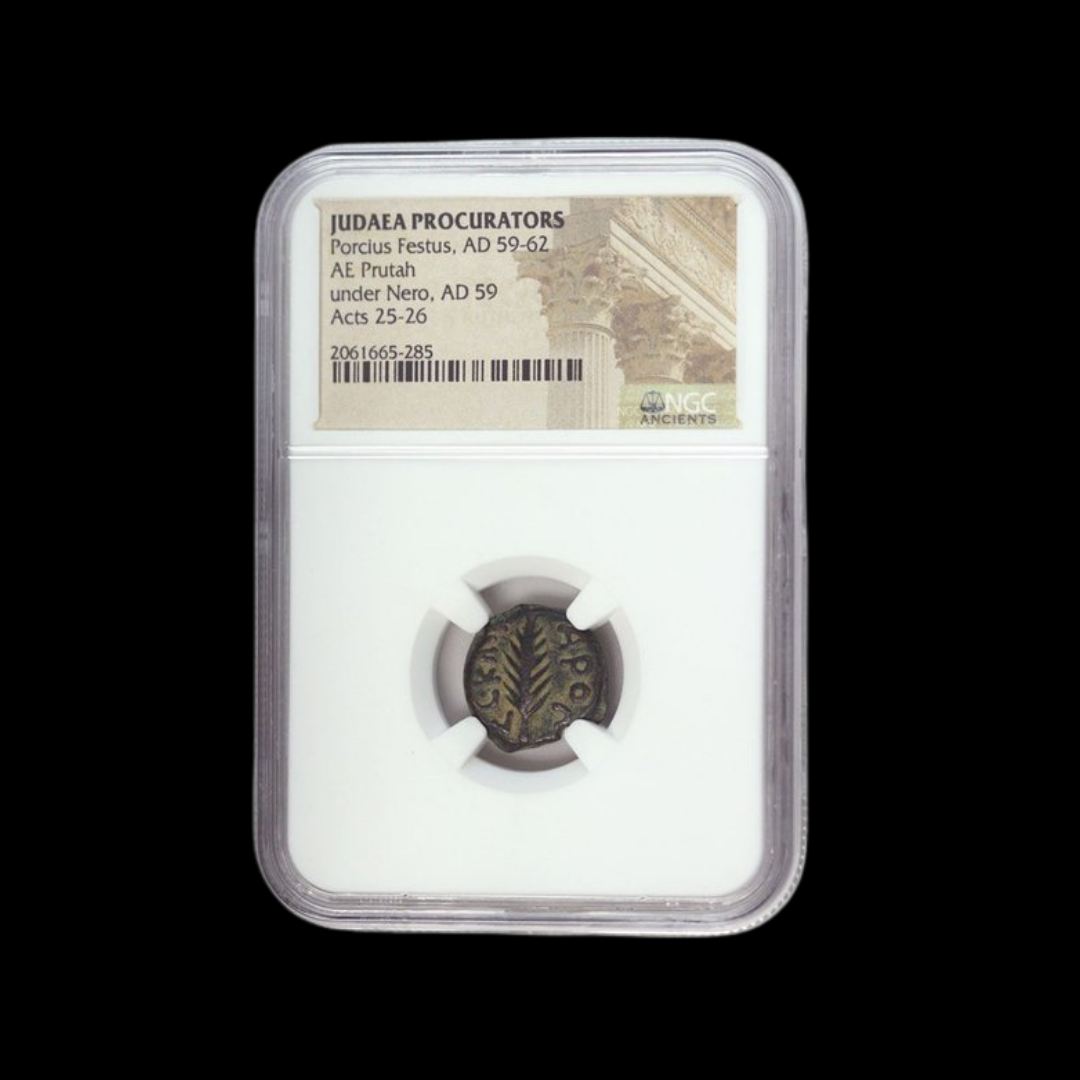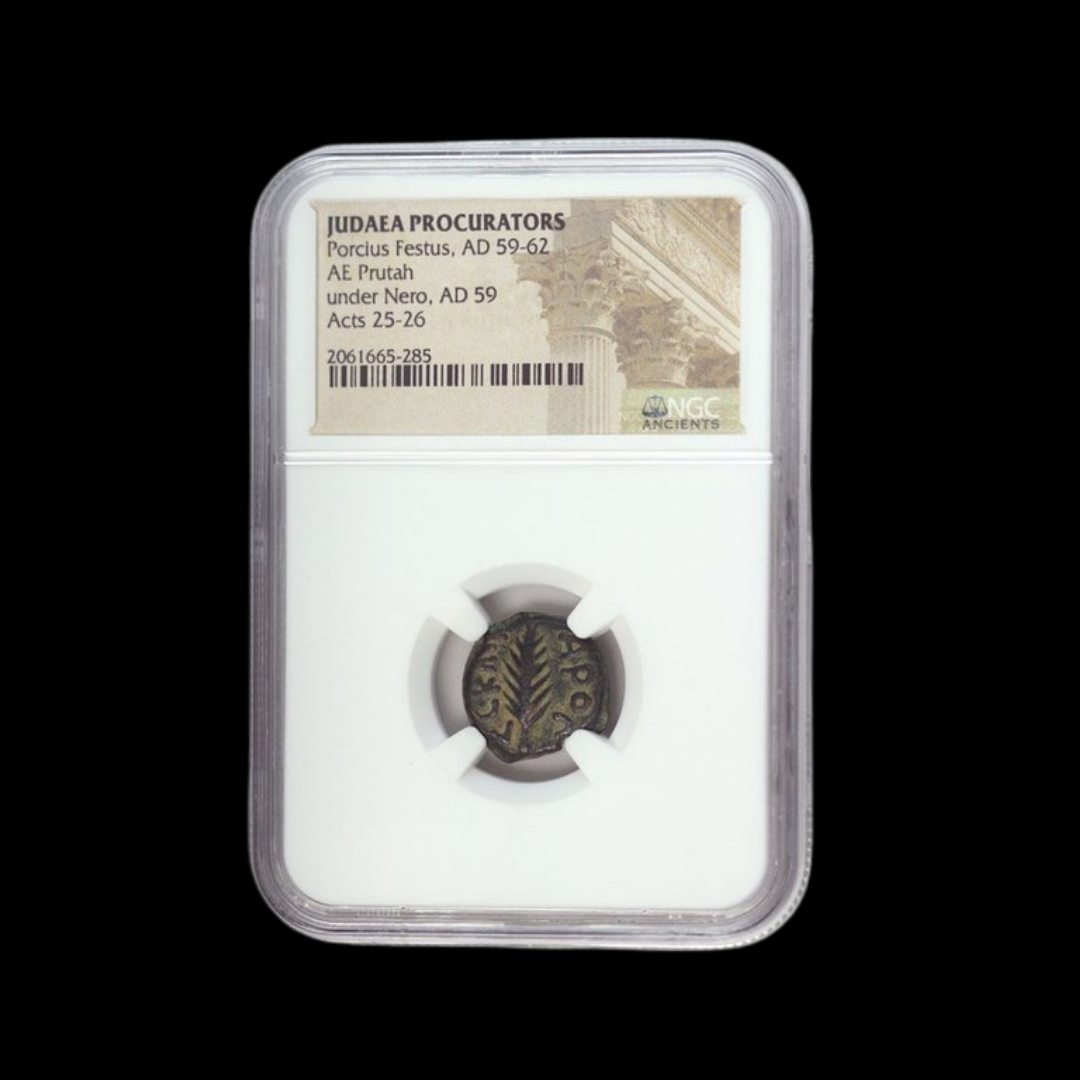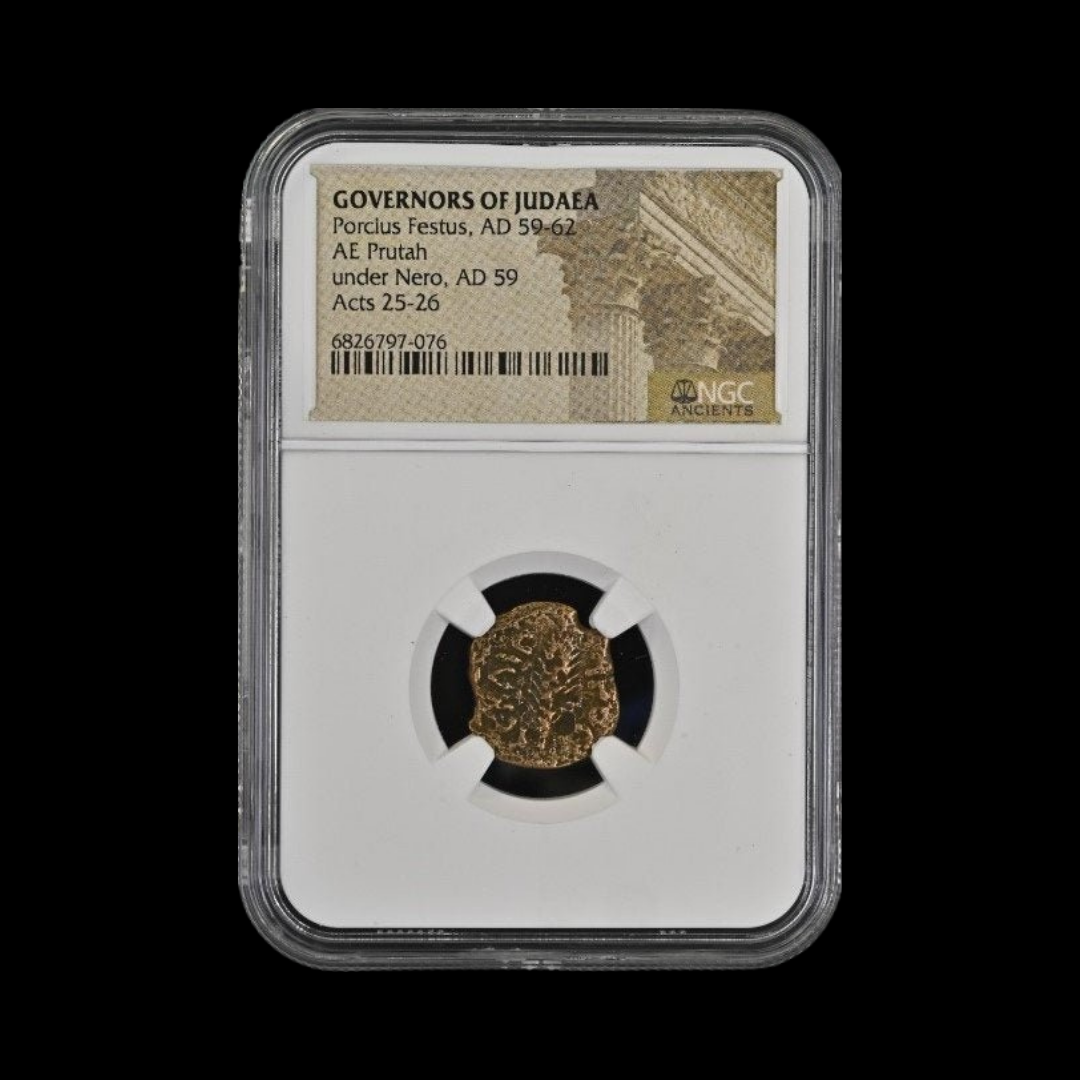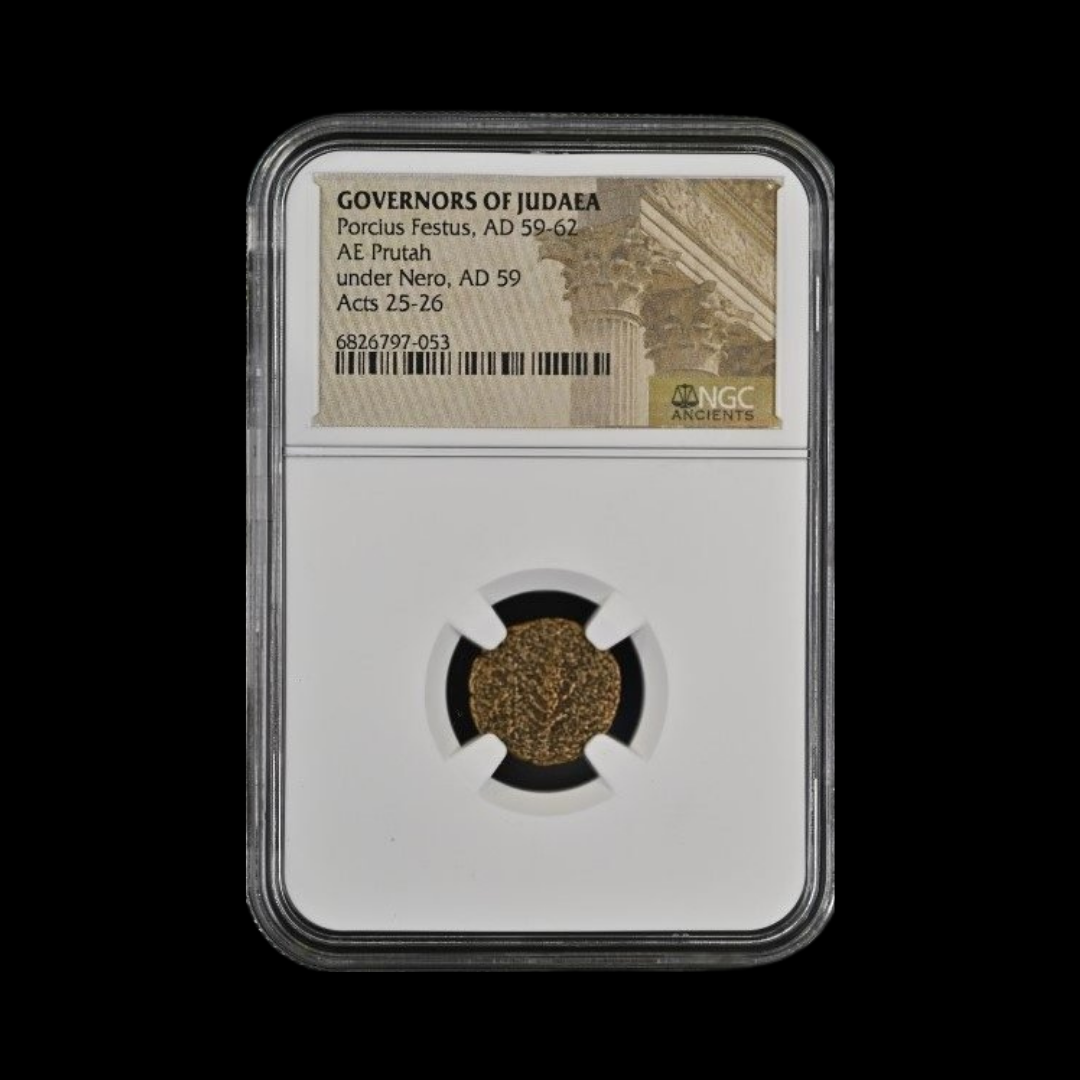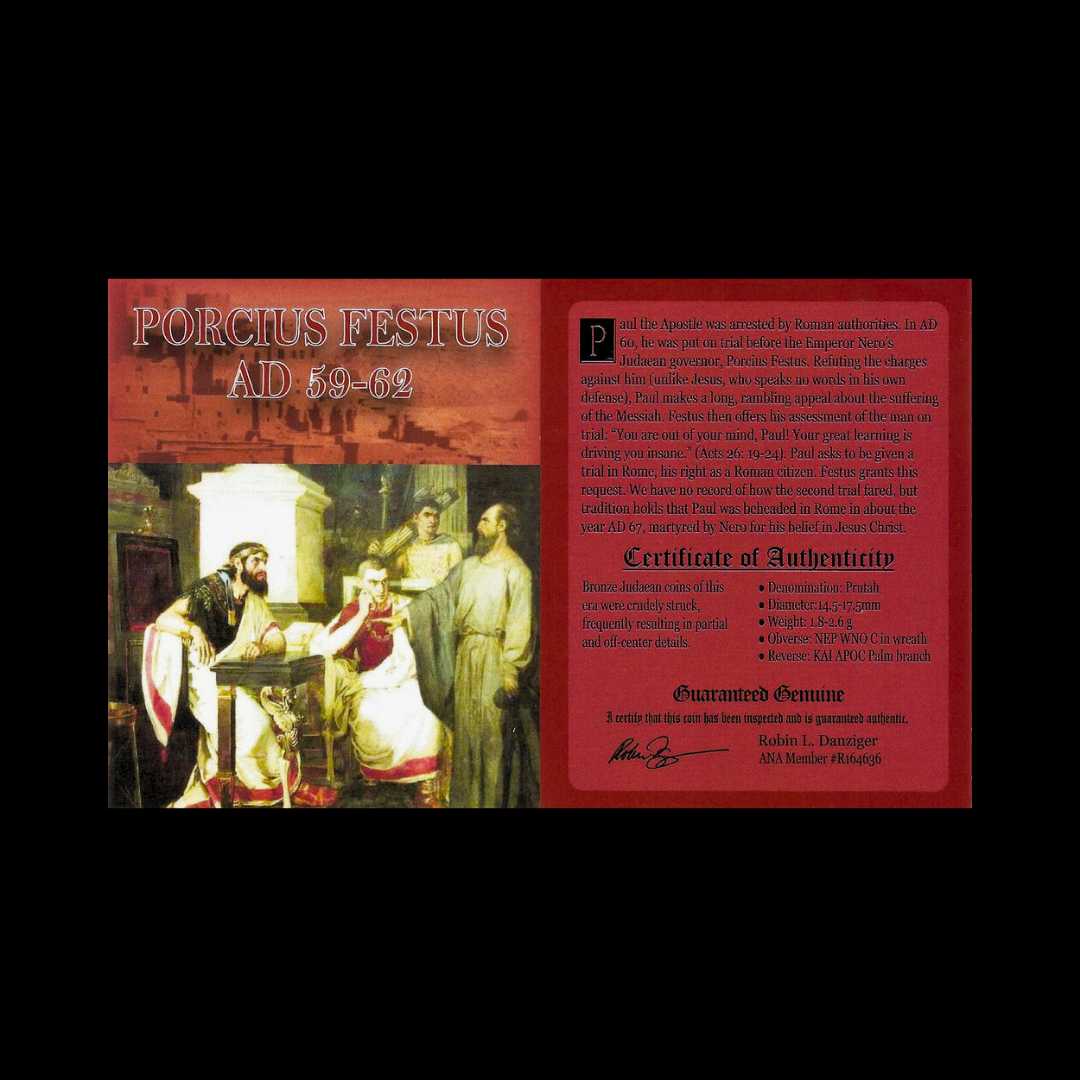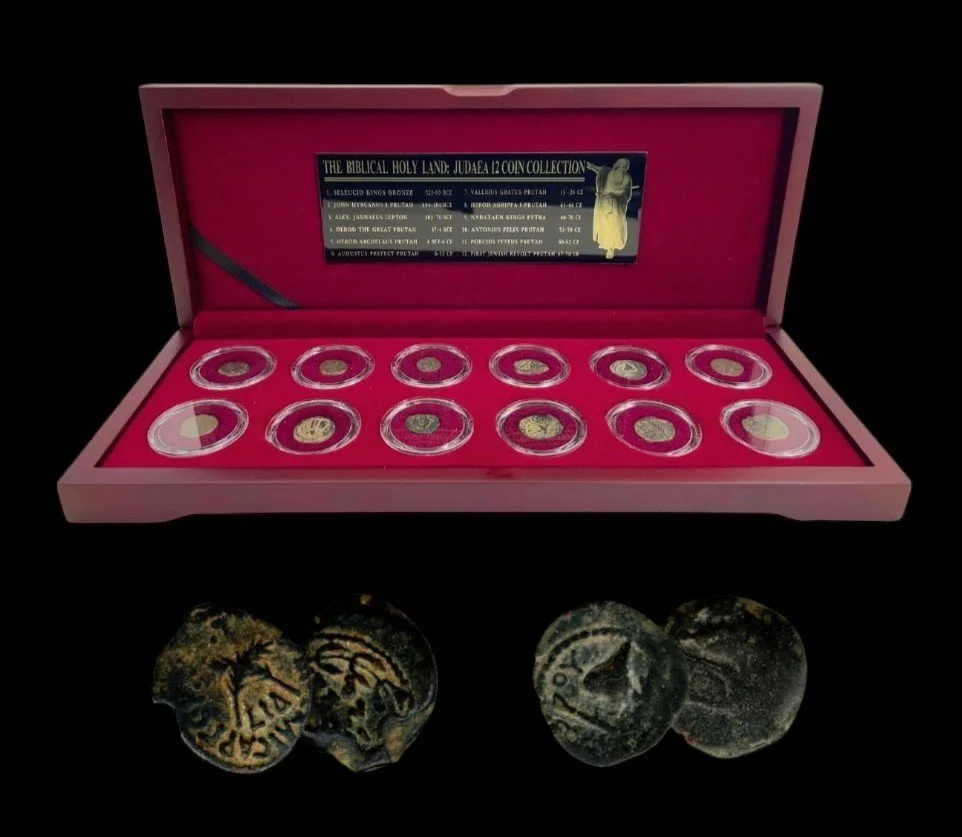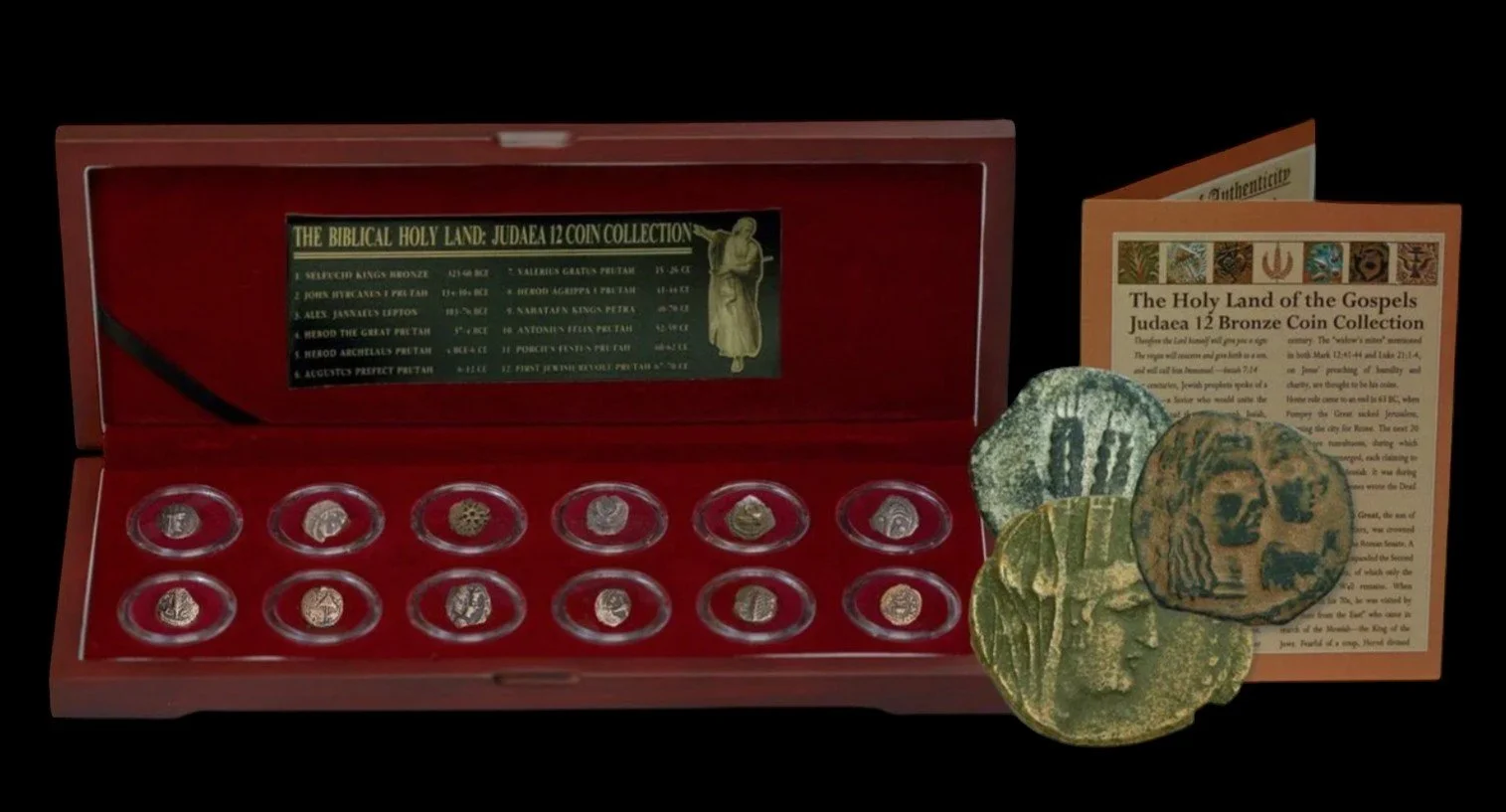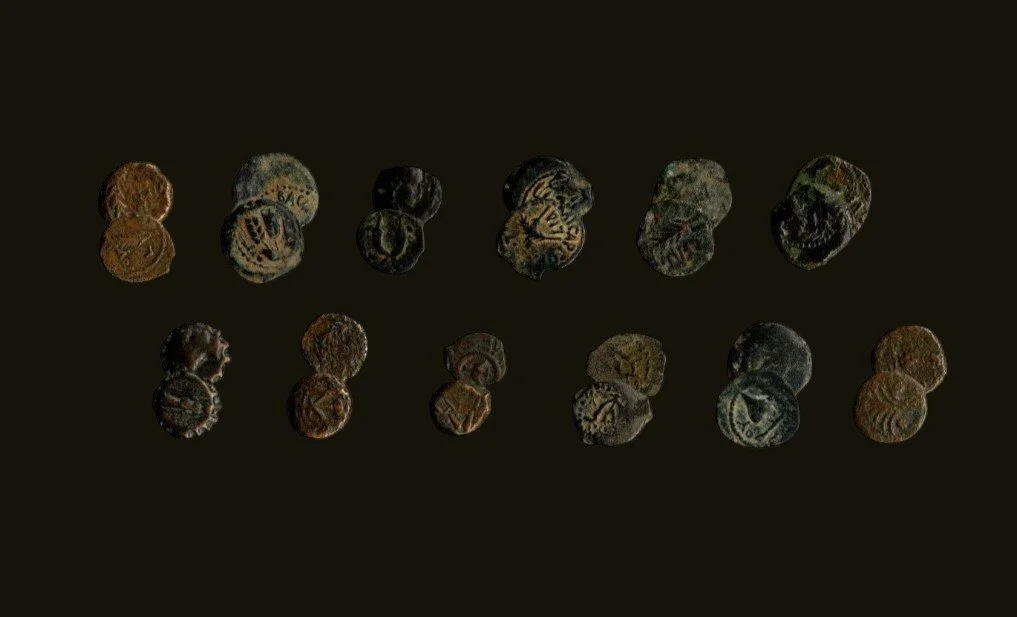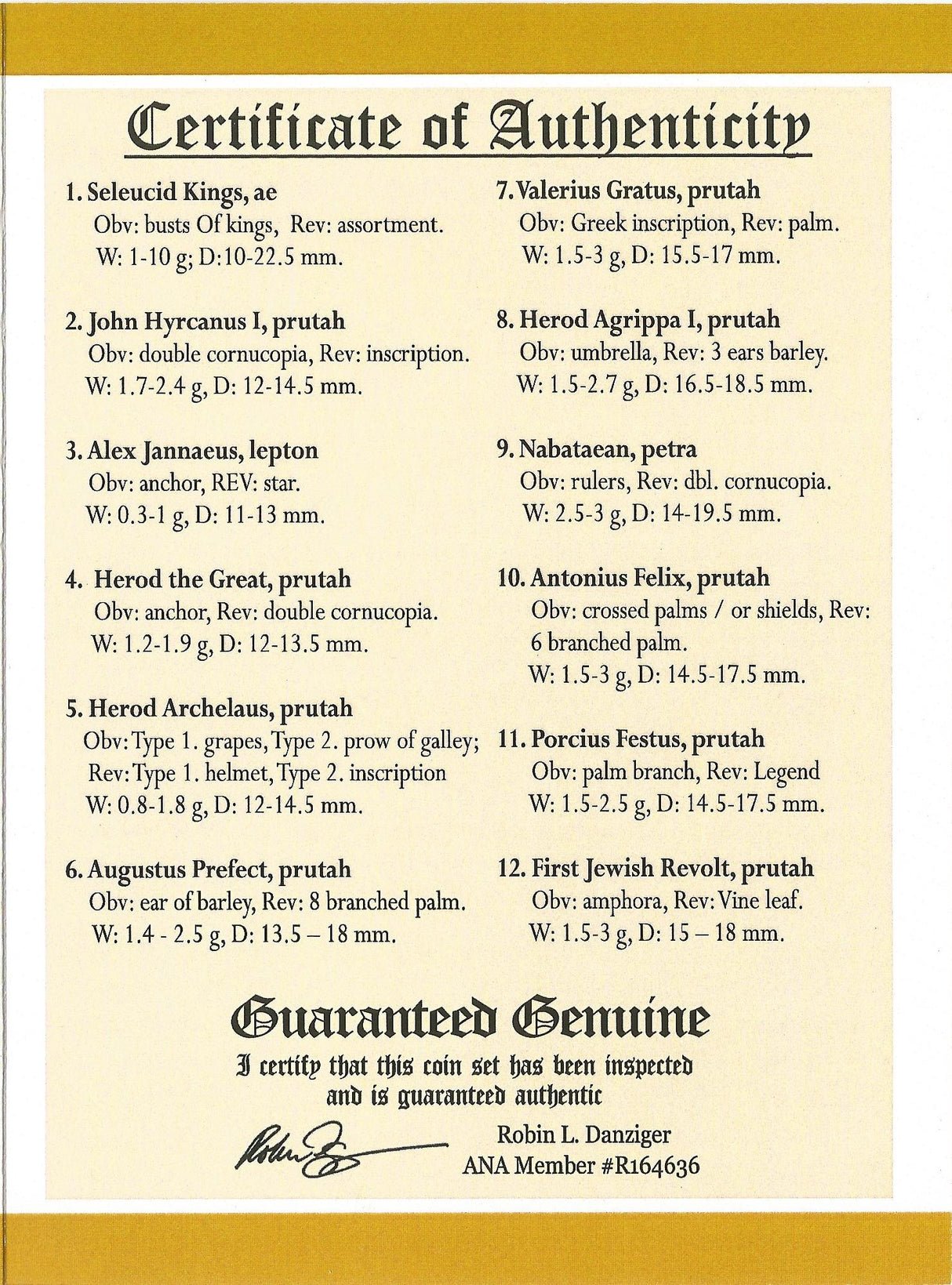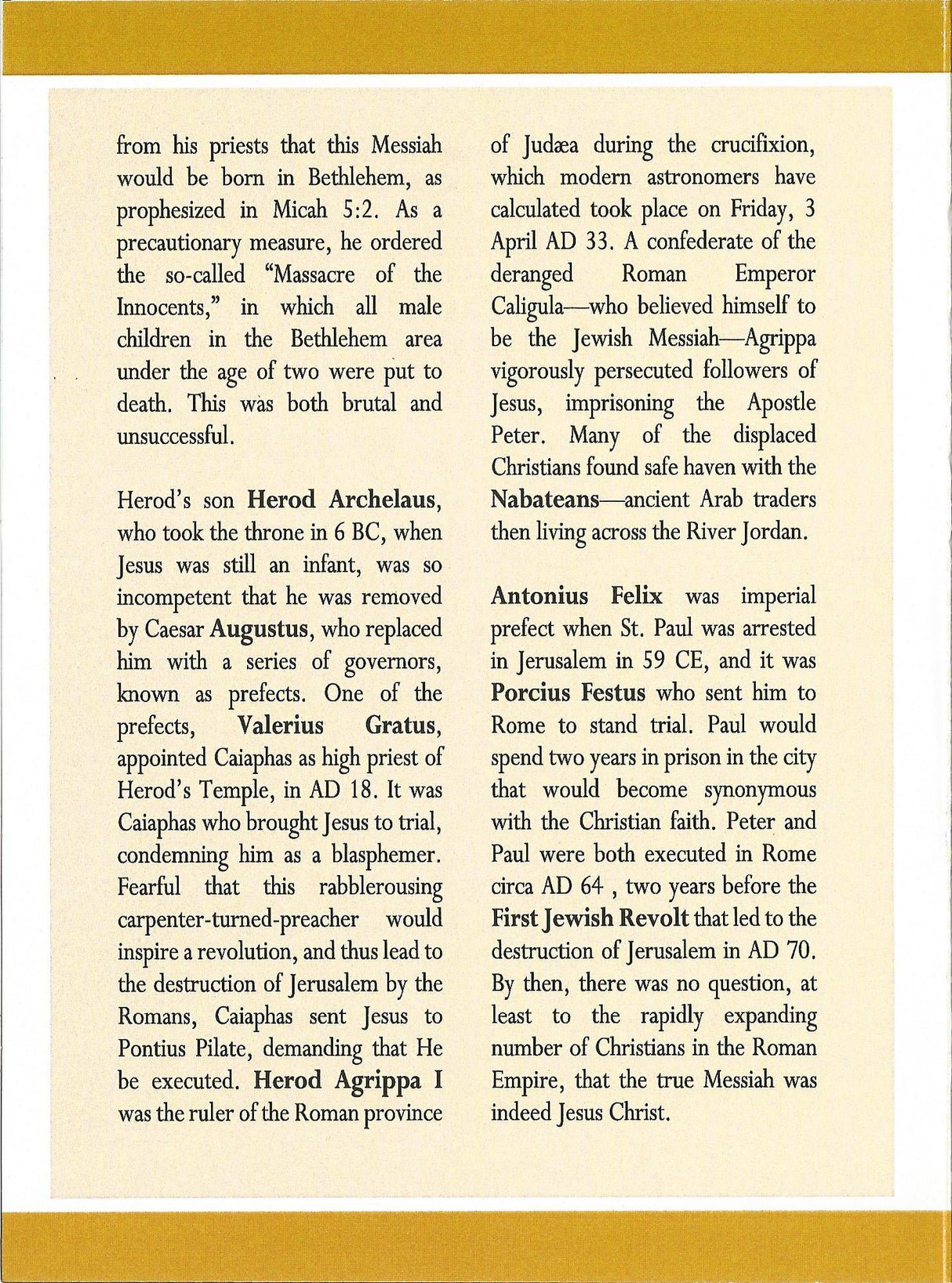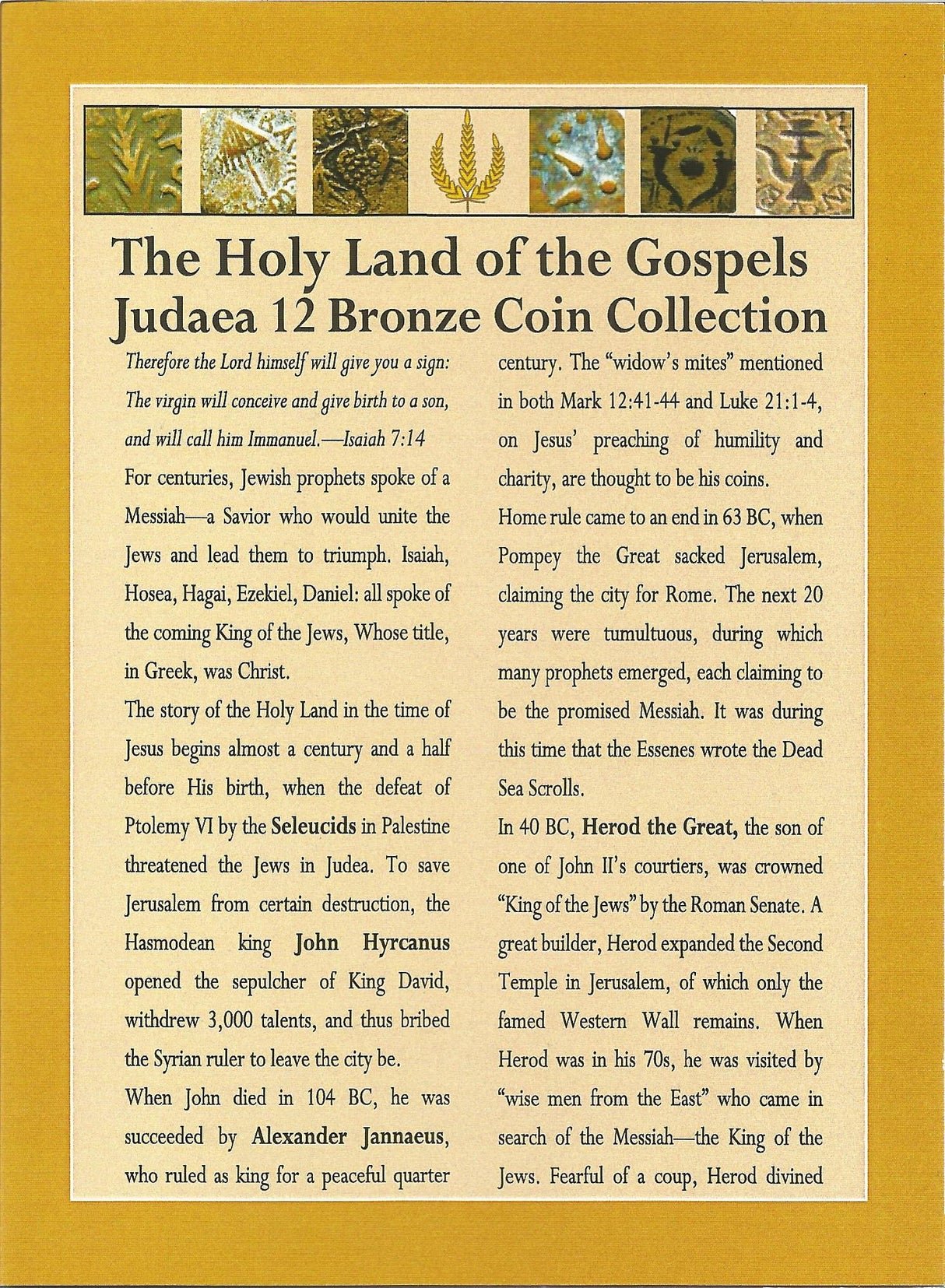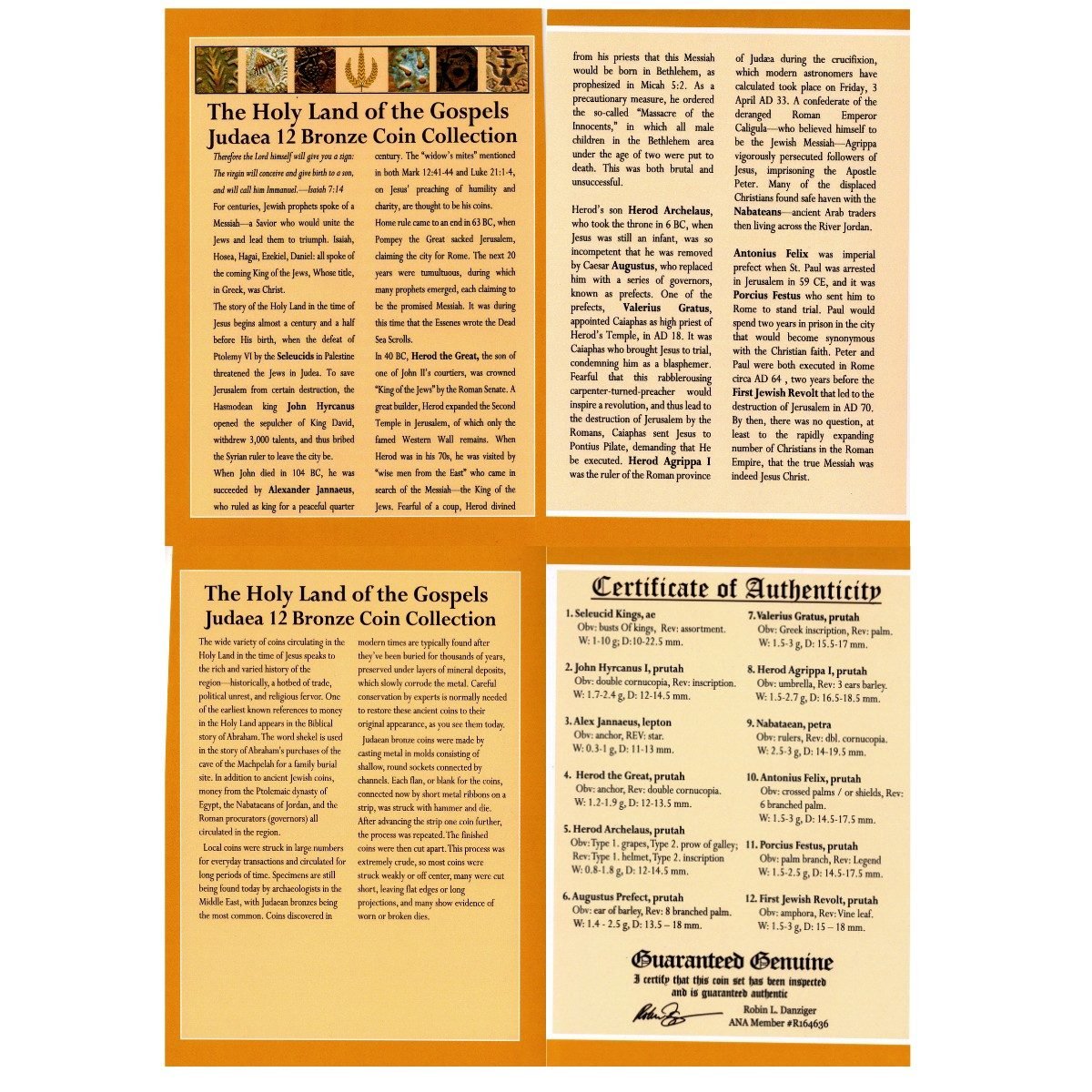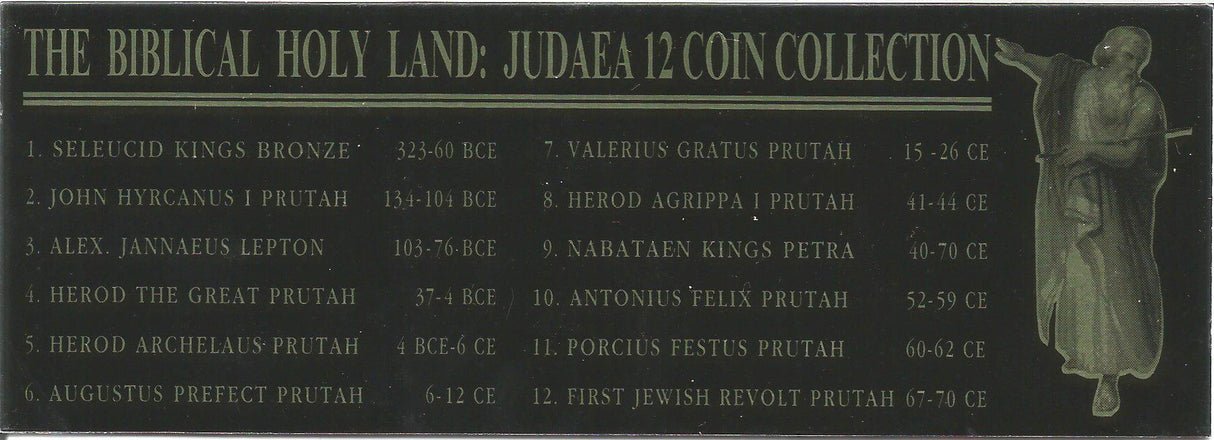 Image 1 of 5
Image 1 of 5

 Image 2 of 5
Image 2 of 5

 Image 3 of 5
Image 3 of 5

 Image 4 of 5
Image 4 of 5

 Image 5 of 5
Image 5 of 5






The Jewish Wars with Rome: A Box of 6 Ancient Bronze Coins
This compelling collection features six bronze coins that tell the story of the tumultuous relationship between Judaea and the Roman Empire, highlighting the significant conflicts that shaped the region's history.
1. Judaean Bronze Prutah of Herod the Great (about 2050-2020 years ago)
This small bronze coin was issued during the reign of Herod the Great, the Roman client king of Judaea appointed by the Senate.
Coin Description:
Front side: Likely shows a tripod table, ceremonial vessel, or palm branch
Back side: Probably displays a military symbol like a helmet or shield with Greek inscription
Technical Details:
Bronze composition
Prutah denomination
Date/period: Circa 37-4 BCE
Historical Significance: Herod the Great ruled Judaea as Rome's client king during a pivotal period when Roman influence was solidifying in the region. Though ethnically Idumean, Herod maintained Jewish religious practices in public while embracing Roman cultural and political influences. His massive building projects (including the renovation of the Second Temple) and harsh rule set the stage for later Jewish-Roman tensions.
2. Roman Provincial Coin of Pontius Pilate (about 1990-1984 years ago)
This bronze coin was minted in Judaea under the authority of Pontius Pilate, the Roman prefect known for his role in the crucifixion of Jesus.
Coin Description:
Front side: Likely displays Roman religious symbols like the simpulum (ladle) or lituus (augur's staff)
Back side: Probably shows date markers with "TIBEPIOY KAICAPOC" (of Tiberius Caesar)
Technical Details:
Bronze composition
Prutah denomination
Date/period: Circa 26-36 CE
Historical Significance: Minted during the prefecture of Pontius Pilate, these coins circulated in Judaea when tensions between Roman authority and Jewish religious leadership were intensifying. Pilate's insensitivity to Jewish customs, as recorded by contemporary historians like Josephus, contributed to the growing resentment toward Roman rule that would eventually erupt into open rebellion.
3. Coin from the First Jewish Revolt (about 1955-1952 years ago)
This bronze coin was minted by Jewish rebels during their revolt against Roman authority.
Coin Description:
Front side: Likely shows an amphora, vine leaf, or palm tree with Hebrew inscription "For the Freedom of Zion"
Back side: Probably depicts ritual objects from the Temple or a date formula showing the year of the revolt
Technical Details:
Bronze composition
Prutah denomination
Date/period: Circa 66-70 CE
Historical Significance: This coin represents the first major armed Jewish rebellion against Roman rule, which ended with the destruction of the Second Temple in Jerusalem in 70 CE. These coins were deliberately struck to assert Jewish independence, replacing Roman symbols with traditional Jewish imagery and Hebrew inscriptions instead of Greek or Latin—a powerful political statement against Roman authority.
4. Roman Coin Commemorating the Defeat of Judaea (about 1945-1940 years ago)
This bronze coin was issued under Emperor Vespasian or his son Titus to commemorate Rome's victory over the Jewish rebels.
Coin Description:
Front side: Portrait of Emperor Vespasian or Titus with Latin imperial titles
Back side: Likely shows the personification of Judaea as a mourning woman seated beneath a palm tree, with inscription "IVDAEA CAPTA" (Judaea Captured)
Technical Details:
Bronze composition
As or dupondius denomination
Date/period: Circa 71-81 CE
Historical Significance: After crushing the Jewish Revolt and destroying the Temple in Jerusalem, the Romans issued these victory coins throughout the empire to celebrate their triumph. These propaganda pieces symbolized Rome's total dominance and served as a warning to other provinces considering rebellion.
5. Roman Provincial Coin from Aelia Capitolina (about 1890-1800 years ago)
This bronze coin was issued from the Roman colony established on the ruins of Jerusalem.
Coin Description:
Front side: Likely shows the emperor's portrait (possibly Hadrian) with Latin inscription
Back side: Probably depicts pagan deities, Roman military standards, or the colony's founding symbols
Technical Details:
Bronze composition
Provincial denomination
Date/period: Circa 135-225 CE
Historical Significance: After crushing the Bar Kokhba revolt (132-135 CE), Emperor Hadrian rebuilt Jerusalem as the Roman colony Aelia Capitolina, banned Jews from entering except on one day per year, and renamed the province Syria Palaestina. These coins symbolize Rome's complete transformation of the holy city into a pagan Roman settlement—a final statement of imperial authority after the Jewish rebellions.
6. Late Roman Empire Bronze Coin (about 1700-1600 years ago)
This bronze coin was issued during the Christianization of the Roman Empire, when the Holy Land gained new significance.
Coin Description:
Front side: Portrait of a Christian Roman emperor (possibly Constantine or one of his successors) with Latin titles
Back side: Likely shows Christian symbols or standard late Roman motifs
Technical Details:
Bronze composition
AE3 or AE4 denomination
Date/period: Circa 325-425 CE
Historical Significance: This coin represents the transformation of the Roman Empire into a Christian state, which dramatically changed the significance of Judaea/Palestine. The region, once suppressed as a rebellious province, became revered as the Holy Land where Christianity began. The emperor Constantine's mother Helena established churches at sacred sites, beginning the Byzantine Christian presence that would dominate the region for centuries.
This compelling collection features six bronze coins that tell the story of the tumultuous relationship between Judaea and the Roman Empire, highlighting the significant conflicts that shaped the region's history.
1. Judaean Bronze Prutah of Herod the Great (about 2050-2020 years ago)
This small bronze coin was issued during the reign of Herod the Great, the Roman client king of Judaea appointed by the Senate.
Coin Description:
Front side: Likely shows a tripod table, ceremonial vessel, or palm branch
Back side: Probably displays a military symbol like a helmet or shield with Greek inscription
Technical Details:
Bronze composition
Prutah denomination
Date/period: Circa 37-4 BCE
Historical Significance: Herod the Great ruled Judaea as Rome's client king during a pivotal period when Roman influence was solidifying in the region. Though ethnically Idumean, Herod maintained Jewish religious practices in public while embracing Roman cultural and political influences. His massive building projects (including the renovation of the Second Temple) and harsh rule set the stage for later Jewish-Roman tensions.
2. Roman Provincial Coin of Pontius Pilate (about 1990-1984 years ago)
This bronze coin was minted in Judaea under the authority of Pontius Pilate, the Roman prefect known for his role in the crucifixion of Jesus.
Coin Description:
Front side: Likely displays Roman religious symbols like the simpulum (ladle) or lituus (augur's staff)
Back side: Probably shows date markers with "TIBEPIOY KAICAPOC" (of Tiberius Caesar)
Technical Details:
Bronze composition
Prutah denomination
Date/period: Circa 26-36 CE
Historical Significance: Minted during the prefecture of Pontius Pilate, these coins circulated in Judaea when tensions between Roman authority and Jewish religious leadership were intensifying. Pilate's insensitivity to Jewish customs, as recorded by contemporary historians like Josephus, contributed to the growing resentment toward Roman rule that would eventually erupt into open rebellion.
3. Coin from the First Jewish Revolt (about 1955-1952 years ago)
This bronze coin was minted by Jewish rebels during their revolt against Roman authority.
Coin Description:
Front side: Likely shows an amphora, vine leaf, or palm tree with Hebrew inscription "For the Freedom of Zion"
Back side: Probably depicts ritual objects from the Temple or a date formula showing the year of the revolt
Technical Details:
Bronze composition
Prutah denomination
Date/period: Circa 66-70 CE
Historical Significance: This coin represents the first major armed Jewish rebellion against Roman rule, which ended with the destruction of the Second Temple in Jerusalem in 70 CE. These coins were deliberately struck to assert Jewish independence, replacing Roman symbols with traditional Jewish imagery and Hebrew inscriptions instead of Greek or Latin—a powerful political statement against Roman authority.
4. Roman Coin Commemorating the Defeat of Judaea (about 1945-1940 years ago)
This bronze coin was issued under Emperor Vespasian or his son Titus to commemorate Rome's victory over the Jewish rebels.
Coin Description:
Front side: Portrait of Emperor Vespasian or Titus with Latin imperial titles
Back side: Likely shows the personification of Judaea as a mourning woman seated beneath a palm tree, with inscription "IVDAEA CAPTA" (Judaea Captured)
Technical Details:
Bronze composition
As or dupondius denomination
Date/period: Circa 71-81 CE
Historical Significance: After crushing the Jewish Revolt and destroying the Temple in Jerusalem, the Romans issued these victory coins throughout the empire to celebrate their triumph. These propaganda pieces symbolized Rome's total dominance and served as a warning to other provinces considering rebellion.
5. Roman Provincial Coin from Aelia Capitolina (about 1890-1800 years ago)
This bronze coin was issued from the Roman colony established on the ruins of Jerusalem.
Coin Description:
Front side: Likely shows the emperor's portrait (possibly Hadrian) with Latin inscription
Back side: Probably depicts pagan deities, Roman military standards, or the colony's founding symbols
Technical Details:
Bronze composition
Provincial denomination
Date/period: Circa 135-225 CE
Historical Significance: After crushing the Bar Kokhba revolt (132-135 CE), Emperor Hadrian rebuilt Jerusalem as the Roman colony Aelia Capitolina, banned Jews from entering except on one day per year, and renamed the province Syria Palaestina. These coins symbolize Rome's complete transformation of the holy city into a pagan Roman settlement—a final statement of imperial authority after the Jewish rebellions.
6. Late Roman Empire Bronze Coin (about 1700-1600 years ago)
This bronze coin was issued during the Christianization of the Roman Empire, when the Holy Land gained new significance.
Coin Description:
Front side: Portrait of a Christian Roman emperor (possibly Constantine or one of his successors) with Latin titles
Back side: Likely shows Christian symbols or standard late Roman motifs
Technical Details:
Bronze composition
AE3 or AE4 denomination
Date/period: Circa 325-425 CE
Historical Significance: This coin represents the transformation of the Roman Empire into a Christian state, which dramatically changed the significance of Judaea/Palestine. The region, once suppressed as a rebellious province, became revered as the Holy Land where Christianity began. The emperor Constantine's mother Helena established churches at sacred sites, beginning the Byzantine Christian presence that would dominate the region for centuries.













